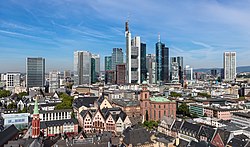Rhine-Main Metropolitan Region
Rhein-Main-Gebiet | |
|---|---|
 Downtown Frankfurt | |
 Location of Rhine-Main Metropolitan Region in Germany | |
| Country | |
| States | |
| Largest cities | Frankfurt am Main Wiesbaden Mainz Darmstadt |
| Government | |
| • Type | Frankfurt/Rhine-Main Conurbation Planning Association |
| • Verbandsdirektor | Thomas Horn (CDU) |
| Area | |
| • Metro | 14,800 km2 (5,700 sq mi) |
| Population (2022)[2] | |
| • Metro | 5,907,863 |
| • Metro density | 400/km2 (1,000/sq mi) |
| GDP | |
| • Metro | €300.868 billion (2021) |
| Time zone | UTC+1 (CET) |
| Website | Planungsverband.de |
The Rhine-Main Metropolitan Region, often simply referred to as Frankfurt Rhine-Main, Frankfurt Rhine-Main area or Rhine-Main area (German: Rhein-Main-Gebiet or Frankfurt/Rhein-Main, abbreviated FRM), is the third-largest metropolitan region in Germany after Rhine-Ruhr and Berlin-Brandenburg, with a total population exceeding 5.8 million. The metropolitan region is located in the central-western part of Germany, and stretches over parts of three German states: Hesse, Rhineland-Palatinate, and Bavaria. The largest cities in the region are Frankfurt am Main, Wiesbaden, Mainz, Darmstadt, Offenbach, Worms, Hanau, and Aschaffenburg.
The polycentric region is named after its core city, Frankfurt, and the two rivers Rhine and Main. The Frankfurt Rhine-Main area is officially designated as a European Metropolitan region by the German Federal Ministry of Transport, Building and Urban Affairs and covers an area of roughly 13,000 square kilometers (5,000 sq mi).
The region is the 4th biggest by GDP in the European Union.
- ^ Regionalverband FrankfurtRheinMain. "Regionalverband FrankfurtRheinMain /". planungsverband.de.[permanent dead link]
- ^ "Statistik-Viewer Metropolregion". 2019-12-31. Retrieved 2020-12-31.
- ^ "Bruttoinlandsprodukt (BIP) in den Metropolregionen* in Deutschland im Jahr 2021" (in German).